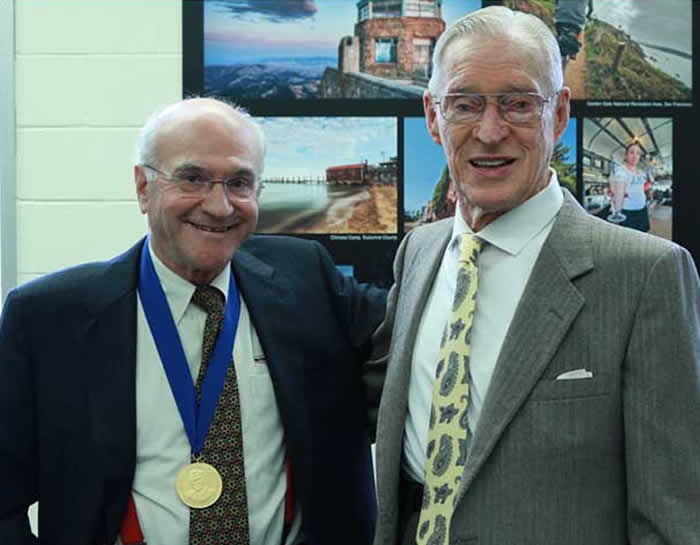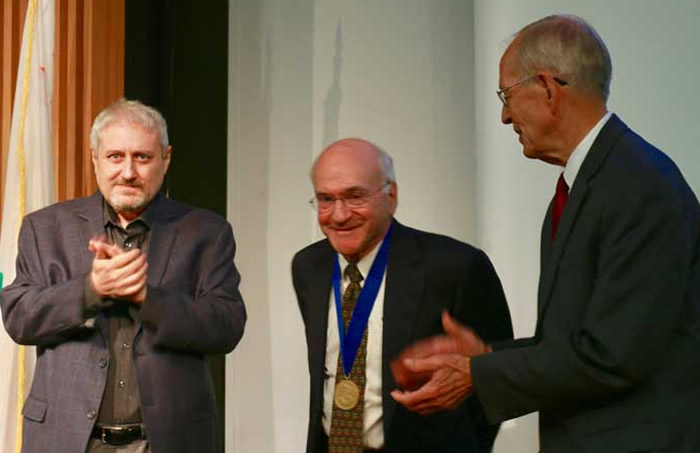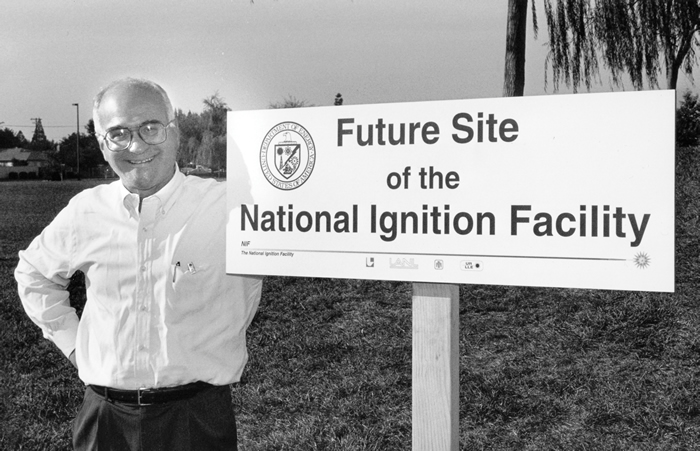Science & Technology - 2017
November
Stockpile Stewardship Architect Vic Reis Receives Foster Medal
Victor H. “Vic” Reis, known as the architect of the U.S. Stockpile Stewardship Program (SSP) and a long-time supporter of the National Ignition Facility, has been awarded LLNL’s John S. Foster Jr. Medal.
Reis was recognized for his significant contributions to national security, his innovative leadership in science and technology, and his dedication to national service—particularly for guiding the nation’s nuclear program through an uncertain time of budget cuts and the end of underground testing.
 Vic Reis (left) with former Lab Director Johnny Foster. Photos: Maren Hunsberger
Vic Reis (left) with former Lab Director Johnny Foster. Photos: Maren Hunsberger The year was 1993. The Cold War was over. The U.S. had declared a moratorium on nuclear testing, and a new strategy of ensuring the safety and reliability of the nation’s nuclear deterrent would soon be needed. Reis, then the Department of Energy’s assistant secretary of Defense Programs, added the phrase “science-based” to what Congress had begun calling “stockpile stewardship.”
“‘Science-based’ was code for ‘trust the labs to maintain their overriding integrity and passion that is embedded in this scientific endeavor,’” Reis said. “And trust the labs I did.” The SSP led to the creation of several new generations of supercomputers—several of which have been housed at LLNL—as well as NIF and other unique facilities.
On Nov. 3, current and former DOE laboratory directors, colleagues, and contemporaries of Reis gathered at LLNL to celebrate his career. He became the third recipient of the Foster Medal, after the award’s namesake, former LLNL Director Johnny Foster, and 2016 honoree Gen. Larry D. Welch.
“Today, the U.S. nuclear deterrent remains safe, secure and reliable, owing in large part to his efforts to implement and champion the Stockpile Stewardship Program” said Laboratory Director Bill Goldstein as he presented the medal. “Reis truly exemplifies the meaning of the Foster Medal.”
 LLNL Director Bill Goldstein honors Reis with the John S. Foster Jr. Medal as former medal winner Gen. Larry Welch looks on.
LLNL Director Bill Goldstein honors Reis with the John S. Foster Jr. Medal as former medal winner Gen. Larry Welch looks on. “The mission of maintaining the strategic stability and reducing the risk of proliferation in an uncertain world, if anything, has become more complex and no less important,” Reis said. “Trusting the labs to be true to their science roots while fulfilling their national security responsibilities has got to be the better strategy. It just takes some leadership and courage—Johnny Foster courage. Being connected through this award to Johnny Foster and Larry Welch, and all they have meant and are still doing, is a rare and much appreciated honor.”
Reis spent more than 50 years in government and private industry in the service of national security. He held leadership positions at Massachusetts Institute of Technology’s Lincoln Laboratory, in the Office of Science and Technology Policy within the Executive Office of the President, at the Defense Advanced Research Projects Agency (DARPA), and at the U.S. Department of Defense and DOE.
The Foster Medal ceremony featured remarks by speakers who lauded Reis as a brilliant thinker and strategist, as an inspirational leader, and for playing a pivotal role in navigating the uncharted territory of nuclear security in a post-Cold War world without testing.
“Like the medal’s namesake, Vic made a difference; if you work at a weapons lab today, you likely owe your position to Vic,” said Sandia National Laboratories Director Stephen Younger in a pre-recorded video message. “Simply put, Vic Reis saved the American nuclear weapons program. During a time when our nuclear deterrent hung in the balance, Vic Reis stepped up to the plate. He accomplished what most people would’ve said was impossible.”
Former Lawrence Livermore National Lab Director and physicist George Miller, also speaking via video, remarked on Reis’s effective technique of bringing employees of the weapons program and scientists together to create “the fundamental roadmap for what became stockpile stewardship.”
Bruce Tarter, LLNL director from 1994-2002, called Reis the “driving force” behind what would become the SSP and honored him for his “astonishing accomplishment” of bringing together collaborators in the Accelerated Strategic Computing Initiative (ASCI), the 1995 Tri-Lab coalition that resulted in several new generations of supercomputers.
“Vic had understood that in a world without nuclear testing, that essentially high-performance computing was the sine qua non of the entire (stockpile stewardship) program,” Tarter said. “What Vic understood, and why he was the single central ingredient that makes stewardship possible, was that he knew we were at a point of discontinuity. When you’re at a point of discontinuity, you don’t take baby steps, you don’t even take normal steps, you take giant steps with huge risks. Knowing which steps to take, he bet on the labs.”
Former Los Alamos National Lab Director and current Stanford University professor Siegfried “Sig” Hecker, who met Reis at DARPA, said Reis made a “seminal contribution to the country” and distinguished himself by knowing how to work with the laboratories, particularly in assembling a group of nuclear weapons program leaders from the three NNSA labs known as “The Navigators,” who collaborated on a vision for stockpile stewardship.
“He was the right person at the right place at the right time,” Hecker said. “Reis was famous for being able to pull the pieces together to make things work. We needed a strategist, and Vic was that strategist.”
 Reis played a central leadership role in the 1990s in defining the need for the National Ignition Facility.
Reis played a central leadership role in the 1990s in defining the need for the National Ignition Facility. Reis also was praised for his keen understanding of the ins and outs of the political process. Former Congresswoman Ellen Tauscher, the incoming president of the Lawrence Livermore National Security (LLNS) Board of Governors, recalled Reis’s exceptional ability to influence lawmakers who might not have otherwise supported stockpile stewardship, or the National Ignition Facility, to back the ideas.
“Vic was one of those rare people that understands public policy, but also understands the need to have a political consensus,” Tauscher said. “We in my office used to call Vic the ‘nuclear whisperer› because there was never a time when we couldn’t ask him a tough question…and he didn›t have a way forward.”
Nominations for the John S. Foster Jr. Medal were submitted to an independent peer review panel, which unanimously recommended Reis. The award was sponsored by LLNS. Following the medal ceremony, a reception was held for the honoree.
In addition to the Foster Medal, Reis has received two Department of Defense Medals for Distinguished Public Service and the Department of Energy’s James Schlesinger Medal. After returning to DOE in 2005 as a senior adviser in the Office of the Secretary and Undersecretaries, Reis retired in March 2017.
More Information
“Lawrence Livermore to honor the architect of science-based stockpile stewardship” (LLNL News Release, Oct. 25, 2017)



